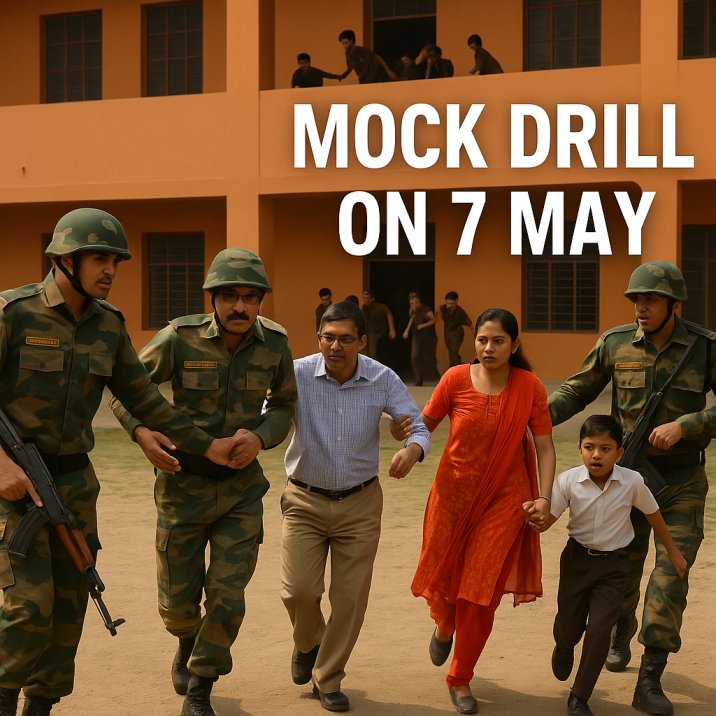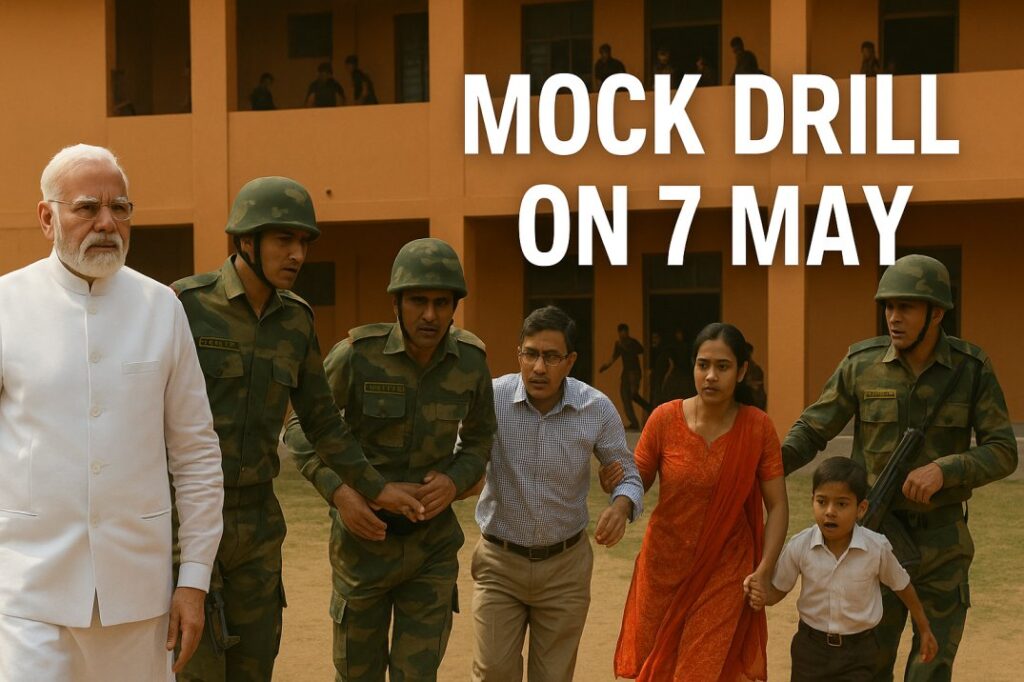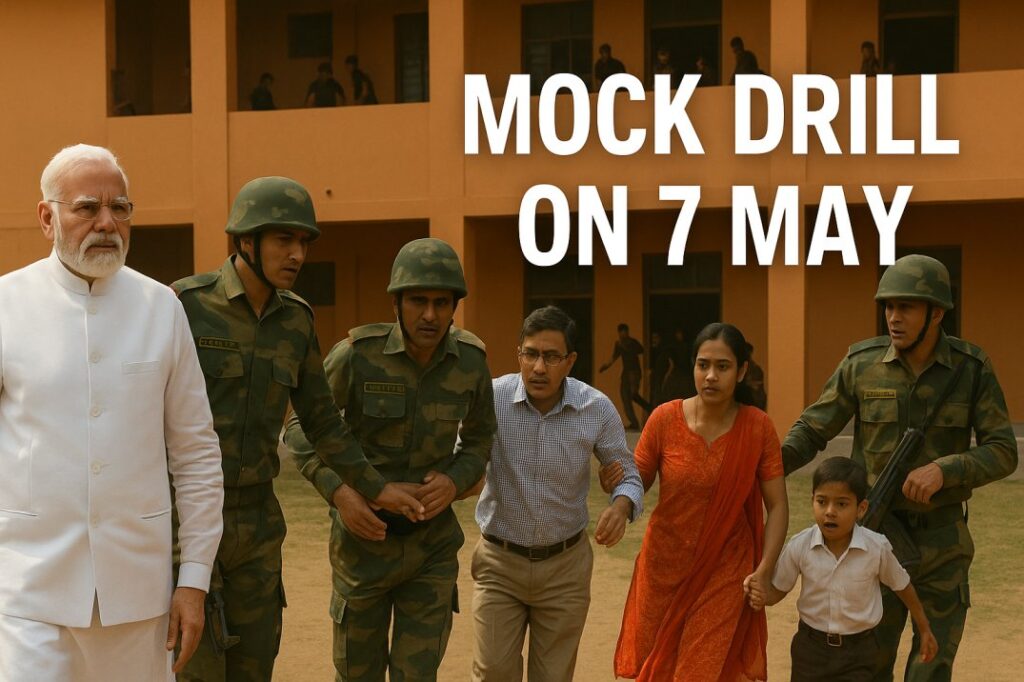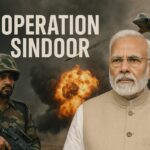Introduction
The sirens blared at 10:17 AM. In bustling cities like Delhi, Mumbai, and Chennai, office workers scrambled under desks, schoolchildren filed into open fields, and hospital staff wheeled patients to safe zones. For 90 minutes, India transformed into a nation in simulated crisis. The May 7th mock drill—one of the largest in the country’s history—wasn’t just a test of infrastructure; it was a rehearsal for survival.
This drill, orchestrated by the National Disaster Management Authority (NDMA), wasn’t merely routine. It came at a critical juncture: India ranks among the top five disaster-prone nations globally, facing threats from cyclones, earthquakes, floods, and industrial hazards. But how does a country of 1.4 billion people prepare for the unpredictable? Let’s unpack the layers of this massive exercise and its implications for India’s disaster readiness.
Why Mock Drills Matter: A Global Perspective
Disaster drills are more than bureaucratic checkboxes. From Japan’s earthquake simulations to California’s wildfire evacuations, they save lives by exposing gaps before real crises strike. For India, the stakes are uniquely high:
- 59% of its landmass is prone to earthquakes.
- 12% of land faces flood risks annually.
- 7,500 km of coastline is vulnerable to cyclones.
Despite these risks, a 2022 UNDRR report highlighted that only 40% of Indian states have functional disaster management plans. The May 7th drill aimed to bridge this gap by testing coordination between agencies, public awareness, and tech-driven response systems.

Inside the May 7th Mock Drill: Scale, Strategy, and Surprises
The NDMA, collaborating with the National Disaster Response Force (NDRF), designed a multi-hazard scenario encompassing earthquakes, chemical spills, and urban floods across 15 states. Key innovations included:
- AI-Powered Simulations: Predictive models mapped evacuation routes and resource allocation.
- Citizen Participation via Apps: Over 2 million users received real-time alerts on the Sachet and NDMA apps.
- Private Sector Integration: Companies like Reliance and Tata conducted onsite drills, blending corporate safety protocols with public response.
Example of a visual element showing drill phases.
Ground Realities: Triumphs and Tensions
In Bhubaneswar, a mock earthquake saw 85% of residents evacuate high-risk zones within 15 minutes—a marked improvement from 2019’s 50% rate. However, Chennai’s flood simulation revealed bottlenecks: overcrowded shelters and delayed NDRF deployments due to traffic snarls.
Dr. Anil Kumar, NDMA Advisor, noted: “This drill wasn’t about perfection. It was about identifying weak links—like urban congestion—that could derail real rescue ops.”
Lessons Learned: Key Takeaways from the Drill
- Tech Is a Double-Edged Sword
While apps improved communication, rural areas with poor internet access struggled. Only 30% of villages in Bihar participated digitally, underscoring the need for low-tech alternatives like sirens and community radios. - The Human Factor
In Mumbai, a group of slum residents improvised a makeshift evacuation bridge using bamboo—a reminder that local ingenuity often complements official protocols. - Healthcare Systems Under Pressure
Mock injuries overwhelmed hospitals in Jaipur, exposing shortages of trauma kits and triage-trained staff.

State‑Wise Drill Breakdown
| State/UT | Key Locations | Drill Components |
|---|---|---|
| Maharashtra | Mumbai, Pune, Nashik, Palghar | Siren activation, blackout, evacuation |
| Uttar Pradesh | Lucknow, Bareilly, Kanpur | Control‑room tests, first‑aid training |
| Punjab | Ferozepur, Ludhiana, Amritsar | Air‑raid sirens, civil‑defence workshops |
| Karnataka | Bengaluru, Karwar, Raichur | Hotlines with IAF, blackout simulations |
| Manipur | Imphal West | Localised evacuation rehearsals |
| …and 239 more |
Comparison: Mock Drill vs. Real Emergency
| Aspect | Mock Drill | Real Emergency |
|---|---|---|
| Control‑Room Environment | Controlled traffic, predetermined tests | High stress, unpredictable loads |
| Public Response | Informed participation | Potential panic & confusion |
| Communication Channels | Backup links readily available | Possible outages/disruptions |
| Evacuation Speed | Timed and calm | Varies by threat perception |
Beyond the Drill: India’s Road to Resilience
Critics Speak: Is This Enough?
While the drill marked progress, experts argue for systemic reforms:
- Dr. Roxy Mathew Koll, Climate Scientist: “Drills must address climate-induced disasters. Last year’s Himalayan floods show our models are outdated.”
- Public Skepticism: A Kolkata participant shared: “We’ve done drills for years, but my apartment still lacks fire exits.”
The Way Forward
- Policy Overhauls: Mandate disaster-resilient infrastructure in municipal bylaws.
- Community Training: Expand programs like NDMA’s Aapda Mitra, which has trained 50,000 volunteers in disaster response.
- Tech Equity: Invest in last-mile connectivity for rural alerts.
H2: A Historical Perspective: First Since 1971
India’s last nationwide civil defence mock drill took place on the eve of the 1971 Indo‑Pak war. That exercise focused on covert military positioning, shelter construction, and rudimentary evacuation drills Business News Today. Fast forward over five decades, and the stakes have changed: cyber threats, complex terrorism tactics, and densely populated cities demand more nuanced preparedness.
- Then (1971): Limited to select border areas; simple air‑raid sirens; basic public awareness.
- Now (2025): 244 districts, digital communication tests, integrated control rooms, and public training sessions The Times of India.
By revisiting history, planners ensured lessons from past conflicts informed today’s strategy—highlighting infrastructure vulnerabilities and enhancing community engagement.
H2: Anatomy of the Drill: Key Components
What exactly happened on May 7? The Mock Drill in India comprised several coordinated activities:
- Air‑Raid Siren Tests: At scheduled times, sirens wailed for up to 10 minutes to gauge audibility and public response @mathrubhumi.
- Blackout Simulations: Households and offices were asked to switch off non‑essential lighting, simulating wartime power cuts www.ndtv.com.
- Control‑Room Drills: District emergency centres activated primary and “shadow” control rooms, testing redundancy.
- Civilian & Student Training: Volunteers and schoolchildren learned shelter‑in‑place procedures and basic first aid.
- Hotline & Radio Link Checks: Communication channels between civil defence authorities and the Indian Air Force were tested end‑to‑end.
- Camouflage & Critical Infrastructure Protection: Officials practiced concealing vital installations to evade detection.
- Evacuation Rehearsals: Public assembly points were identified, routes signposted, and timed drills conducted to ensure orderly movement.
Each element was carefully choreographed, turning theory into tactile experience.
H2: On the Ground: Personal Perspectives
“Standing in Connaught Place as the sirens pierced the evening air was surreal. For the first time, our community felt united by urgency, not celebration.”
— Ananya Mehta, Delhi resident
Walking through the Reserve Police Lines in Lucknow a day before the drill, I witnessed civil defence volunteers marking evacuation zones, while local students practiced duck‑and‑cover drills mint. In coastal Maharashtra, fishermen paused their nets as sirens tested the readiness of seaside communities.
Experts like retired Brigadier S. K. Rao emphasize that such immersive exercises build muscle memory:
“When real crises hit, the body recalls drills more quickly than the mind. This is preparedness in practice.”
H2: Lessons Learned & Future Directions
Every large‑scale exercise surfaces strengths—and areas for improvement:
- Communication Gaps: Some rural hamlets reported delayed siren alerts. Recommendation: integrate mobile‑based SMS alerts alongside sirens.
- Control‑Room Overload: Certain district HQs were overwhelmed by simultaneous radio checks. Recommendation: stagger tests or establish additional “shadow” centres.
- Public Awareness: While urban areas showed high participation, remote communities sought clearer advance notice. Recommendation: localised outreach via panchayats and NGOs.
Looking ahead, authorities plan to incorporate cyber‑attack simulations, widen the scope to include private-sector critical infrastructure, and run smaller drills quarterly. For an in‑depth guide to upcoming exercises, see our Civil Defence 101.
Your Role in Disaster Preparedness
Mock drills aren’t just for officials—they’re a civic responsibility. Here’s how you can contribute:
- Join local disaster volunteer networks.
- Use apps like Sachet for real-time alerts.
- Advocate for safety audits in your workplace or apartment.
Conclusion: From Simulation to Reality
The May 7th mock drill was a microcosm of India’s disaster readiness—celebrating progress while spotlighting gaps. As climate change intensifies, such exercises must evolve from annual rituals into catalysts for systemic change.
Your Turn: Have you participated in a disaster drill? Share your story below, and explore our guide on building a home emergency kit. Together, we can turn preparedness from a policy into a culture.
Internal Links:
External Links:
Visualize the impact. Act on the lessons. Stay prepared.





